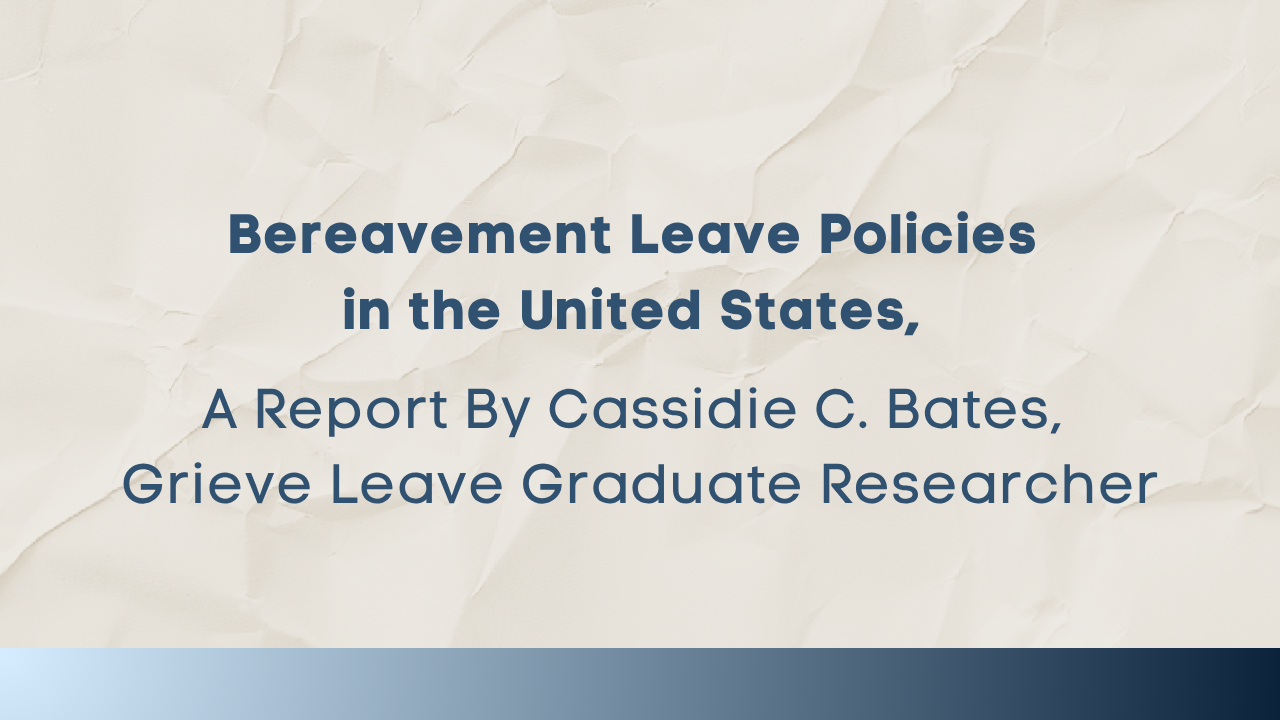Bereavement Leave in America - A Grieve Leave Research Report
Nov 02, 2025
Read the full report [HERE]
I’m so excited to share some highlights from my grief and bereavement leave research with you all!
This summer, I served as the Grieve Leave Graduate Intern. During this time, I studied the landscape of grief and bereavement leave policies in America. I read articles, books, and studies on the topic, conducted interviews with those working in fields that somehow intersect with grief, and I researched the few existing bereavement leave policies on the national, state, and organizational levels.
The goal of this research is to not only understand the state of grief and bereavement practices in America, but to also imagine how informed advocacy efforts could cultivate an effective bereavement leave model.
Death is a universal and inevitable human experience, which means that grieving is guaranteed to each of us.
Bereavement leave, which provides employees time away from work following the death of a family member or close loved one, is not required by federal law in the United States. Meaning, it’s not a type of paid or unpaid leave all Americans get when a loved one dies.
However, five states - California, Illinois, Maryland, Oregon, and Washington - have enacted specific bereavement leave laws for some of their employees.
California became one of the first U.S. states to mandate job-protected bereavement leave when Governor Gavin Newsom signed Assembly Bill 1949 into law in 2022. This legislation provides up to 5 days of bereavement leave following the death of a qualifying family member.
For the vast majority of the country, bereavement leave policies are up to the discretion of the employer, who is not mandated to provide any bereavement leave to their employees. A common practice across U.S. organizations is to offer employees one to five days of bereavement leave for the loss of an immediate family member; however, this is variable and not mandated. This is an insufficient amount of time for grieving individuals to return to work as productive employees.
Depending on an employee’s work place, they may be able to cobble together other types of paid and unpaid leave if they need to take time off from work when an eligible loss occurs
Most bereavement leave policies are centered around the death of immediate family members, including spouses, children, parents, and siblings. In some cases, employers may extend eligibility to include extended family, such as grandparents, grandchildren, in-laws, and other members of non-immediate family.
This is especially inadequate for estate executors, the appointed person(s) by the now-deceased individual, to carry out their final wishes and settle remaining financial matters, among many other duties, who spend over 570 hours on average completing necessary executorship tasks (current practices lead to the average employee possibly being eligible for up to 40 hours of leave total - over 500 hours less than what executors tend to need).
Because we lack bereavement leave policy on the national and state levels, and there isn’t benchmarking for what employers must offer their employees, Americans experiencing grief turn to resources outside of official bereavement policies. For some, this looks like community support groups, taking unpaid time away from work (for those who can afford it), or others are left to sort through their grief journey by themselves, with little time away from the responsibilities of work to navigate these heavy emotions.
For bereavement leave policies to be grief-informed, those who have experienced a grief event should be integrated at each phase of the policy process to ensure that bereavement leave structures are informed by the lived experiences of those they’re intended to serve.
As America enters a chapter of having its largest-yet senior citizen population, with the entirety of the Baby Boomer generation being over the age of 65 by 2030, this inevitably means that America will also experience a surge of deaths. It’s projected that over 73 million Baby Boomers are anticipated to pass away within a ten-year time frame in America, leading to an unprecedented need for the younger generations (likely the children, grandchildren, next-of-kin, etc. of the Baby Boomers) to access bereavement leave, and for some, to act as executors for the deceased person’s estate.
Thank you for diving into my report on grief and bereavement leave practices in America and I’m eager to hear your thoughts on what you’d like to see evolve in America’s bereavement leave policies.
Read the full report [HERE]
Join the Grieve Leave movement
Share your info to join our Grieve Leave community. You don’t want to miss anything!


